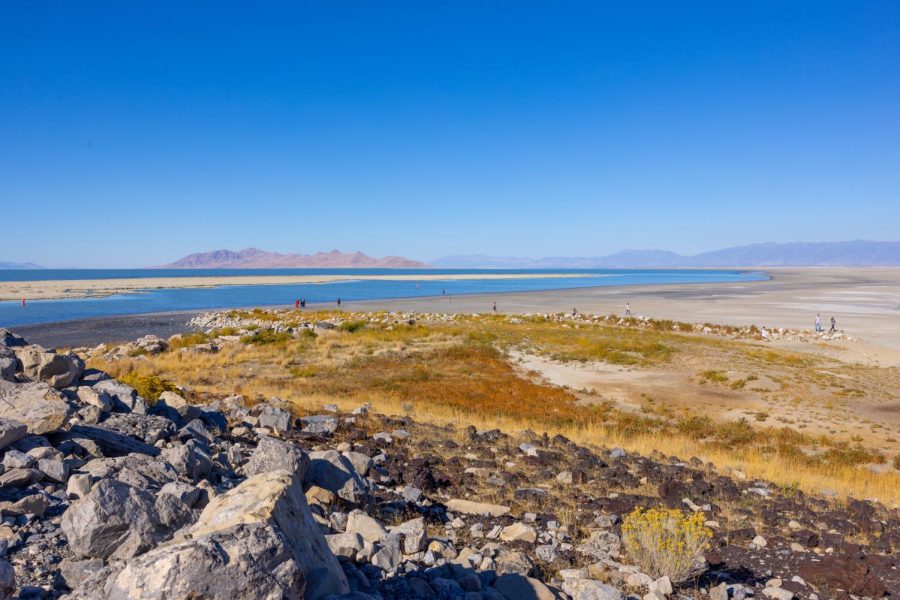How the University of Utah is Working to Protect the Great Salt Lake
Antelope Island in Utah on Oct. 5, 2022. (Photo by Amen Koutowogbe | The Daily Utah Chronicle)
October 10, 2022
What the New York Times called “Utah’s Environmental Nuclear Bomb,” and Outside Magazine called “desolate” yet “also divine,” the Great Salt Lake is a salinated body of water that currently expands over more than 1 million acres of land. According to Utah Geological Survey, the lake is currently reported as the 33rd largest lake in the world. It’s also terminal, meaning there is no water outlet from the lake. Still, the lake is shrinking, raising concerns not only over the lake’s ecology itself, but for public health and Utah’s economy.
“This problem is not caused by climate change,” Dr. Kevin Perry, professor of atmospheric science at the University of Utah, said. “It’s not even caused by the mega drought. It’s actually caused by the fact that we just use too darn much water … we divert water from the rivers before it gets to the lake.”
The Great Salt Lake is fed water by a multitude of small streams, but its primary water supply is provided by the Bear, Jordan, and Weber rivers. Water being diverted from these rivers is used to support agriculture, industries and plants, as well as city water supplies.
The amount of water in these rivers depends largely on a year’s snowpack. As snow melts, water runoff is directed into the rivers, where it is either diverted and stored or fed to the Great Salt Lake. The lake and its size has implications for snowpack, as well, due to something known as the “lake effect.” This is when a difference in temperature between cold winter air and warm lake water creates a higher moisture content in the air. This moisture eventually becomes snow, so that areas closer to the lake experience more snowpack than areas further from it.
“As the lake shrinks, we get less snowpack from the lake effect,” Perry said.
Not only does this have economic implications for Utah’s ski industry, but this also means that as snowpack decreases, less and less water is being provided to rivers, and subsequently, the Great Salt Lake.
Due to the shallow nature of the lake, a small decrease in size can expose a large part of the river’s dusty lakebed.
“I started noticing that there were dust plumes coming off at the lake and coming into the valley … I knew with my background, it was something that I could probably study,” Perry said.
After over two years of collecting dust samples around the perimeter of the entire lake, Perry discovered arsenic present in the lake’s soil. Following this discovery, the Division of Air Quality has begun research to determine the amount of arsenic that is being transmitted to communities near the lake.
“We’re not even sure that the airborne concentrations [of arsenic] are high enough to cause health issues right now,” Perry said. “But we do know it’s in the soil, and it’s in higher concentrations than we would like to see.”
Amid economic and health concerns, the lake’s ecosystem is also at stake. As the lake shrinks, its salinity increases, and brine shrimp, the base of the food chain for the lake’s ecosystems, cannot live in high concentrations of salt. The Great Salt Lake could reach this level of salt concentration in three to five years, Perry said, and if it does reach that point, brine shrimp will die off, collapsing the food chain and leading to mass starvation for animals that rely on this source of food.
The Great Salt Lake Strike Team
On June 23, Utah legislators met with University of Utah faculty, including university President Taylor Randall, Perry and other scientists and advocates for the lake, to discuss how to move forward.
“What the legislators were asking the universities to do was to help them prioritize what’s next,” Perry said. “The first step in the process is to stop the shrink.”
Perry went on to explain that one way to do this is changing how water is used in Utah.
“We use water for agriculture, we use water for industry, and we use water for the cities,” Perry said. “And if you look at how we are doing right now, we use more water per person than any other state in the Western U.S.”
According to Perry, agriculture alone in Utah uses about 75-80% of Utah’s water supply. As the biggest water user, changing how water is allotted to agriculture could make the biggest impact in preserving the Great Salt Lake.
Additionally, precautions about what industries can enter Utah and using more sustainable landscaping can aid in water conservation. However, making these changes requires a large investment of both time and money by the state legislature.
“The legislators are a little bit concerned that whatever changes they make, we don’t have the modeling system … in place yet to kind of figure out what impact that’s ultimately going to have on the labor,” Perry said. “And so they’re a little bit wary about spending millions or billions of dollars, if they can’t yet know what the ultimate impact of that will be.”
To aid legislators, Randall put in place a Great Salt Lake strike team, which is currently set to be in power for a year, to compact and synthesize existing research on the lake that legislators can use to craft bills. The team will also be working on developing a better water model of the lake, a comprehensive history of the lake and its fluctuations, as well as developing thresholds that predict the consequences of lowering water levels.
“The emphasis is trying to provide the legislators with information that they can use for the upcoming legislative session,” Perry said.
Legislators will be holding their annual Great Salt Lake Summit on Oct. 13, by which the strike team hopes to have compressed their research into a useful resource. The forum on Oct. 13 will detail what legislative action is being planned to protect the Great Salt Lake.
Can Arts and Humanities Save the Great Salt Lake?
On Sept. 23 and 24, the Environmental Humanities graduate program at the U held a symposium entitled “Can Arts and Humanities Save the Great Salt Lake?” The event explored how art, cultures, stories, and underrepresented voices can aid in the quest to protect the Great Salt Lake.
“A major hope for us with this symposium is bringing … historically excluded voices and perspectives into this larger conversation on the Great Salt Lake,” Brooke Larsen, the community engagement coordinator for the Environmental Humanities program, said.
The first panel of the seminar, titled “Great Salt Lake and Great Basin Tribes: Ancestral Connections and Pathways to Repair,” comprised of four Indigenous panelists who shared their historical connection to the lake and things to consider moving forward.
“I’ll talk about … the relationship to the elements, to water,” Darren Parry, former chairman of the Northwestern Band of the Shoshone Nation, said. “It wasn’t an object. It was a person, it was a spirit, living thing. And we made that connection. That is the single most important thing to understand that our people bring to the table to today’s crisis.”
Corrina Bow, chairwoman of the Paiute Indian Tribe of Utah, emphasized the importance of water to Indigenous people.
“Water is life. Water is sacred to all of us. We, the natives, we pray for everything, and water is one of our biggest prayers,” Bow said.
Forrest Cuch, member of the Ute Indian Tribe and former Executive Director of the Utah Division of Indian Affairs, explained that Indigenous people do not view the land as something to be owned, and explained how their views differ from mainstream Western views.
“One thing that kind of makes me nuts is we talked about owning the land. I don’t think any of us ever felt like we owned the land,” Cuch said. “Western worldviews promote individual rights, and do everything we can to get ahead for ourselves and our families. Indigenous values promote our obligations, obligations to the past, obligations to the present, obligations to the future, and obligations to each other.”
The panelists discussed how the view of the Great Salt Lake shifted as settlers moved into the valley and displaced Indigenous people that lived there. Settlers viewed themselves as owners of the lake, who could extract resources as they needed, while tribes that relied on the lake viewed themselves as stewards of it. This change in dominant perspective is what some panelists stressed contributed to the current crisis of the Great Salt Lake, and the perspective that needs to be adapted if the lake is to be restored.
“All the science in the world is not going to make up for our selfish behaviors,” Cuch said. “The idea that science is superior in any way to Indigenous wisdom, that can be a barrier to lasting collaboration, and collaboration is what we need.”
This panel, as well as others presented on Sept. 23 for this symposium, are available to watch here.
Grieving the Lake
Faculty at the U aren’t the only university community members taking action for the Great Salt Lake. Utah Youth Environmental Solutions, or UYES, held a die-in protest at the lake on Sept. 3 to emphasize the severity of the lake’s crisis. The protest represented a funeral, with protesters marching silently to a “graveyard” of handmade tombstones warning of the consequences lack of action for the lake will have.
Muskan Walia, organizer for UYES and ASUU Senate Chair, explained the meaning behind the protest.
“The Great Salt Lake is dying, right? It’s drying up. And when someone is passing, we sit with them, and we spend their last moments with them right next to them, you know, hand in hand,” Walia said. “And so we thought, why don’t we do the same for the lake.”
The protest was also intended to put pressure on legislators to take more action.
“There is already knowledge available,” Walia said. “There’s knowledge within the Black, brown and Indigenous people that know about the lake, but there’s already research being done. And it’s time to sort of take that knowledge and turn it into action.”
But the protest wasn’t only to pressure legislators and mourn the lake. Students of UYES’ environmental programs, as well as community members that participated in the protest, were reminded of the power of collective action.
“I think that that protests are really beautiful in reminding us that power comes from the ground up, and that collective action is really, really powerful,” Walia said. “But then I think the conversation is what do we do with that collective power. We have to turn it into action.”









